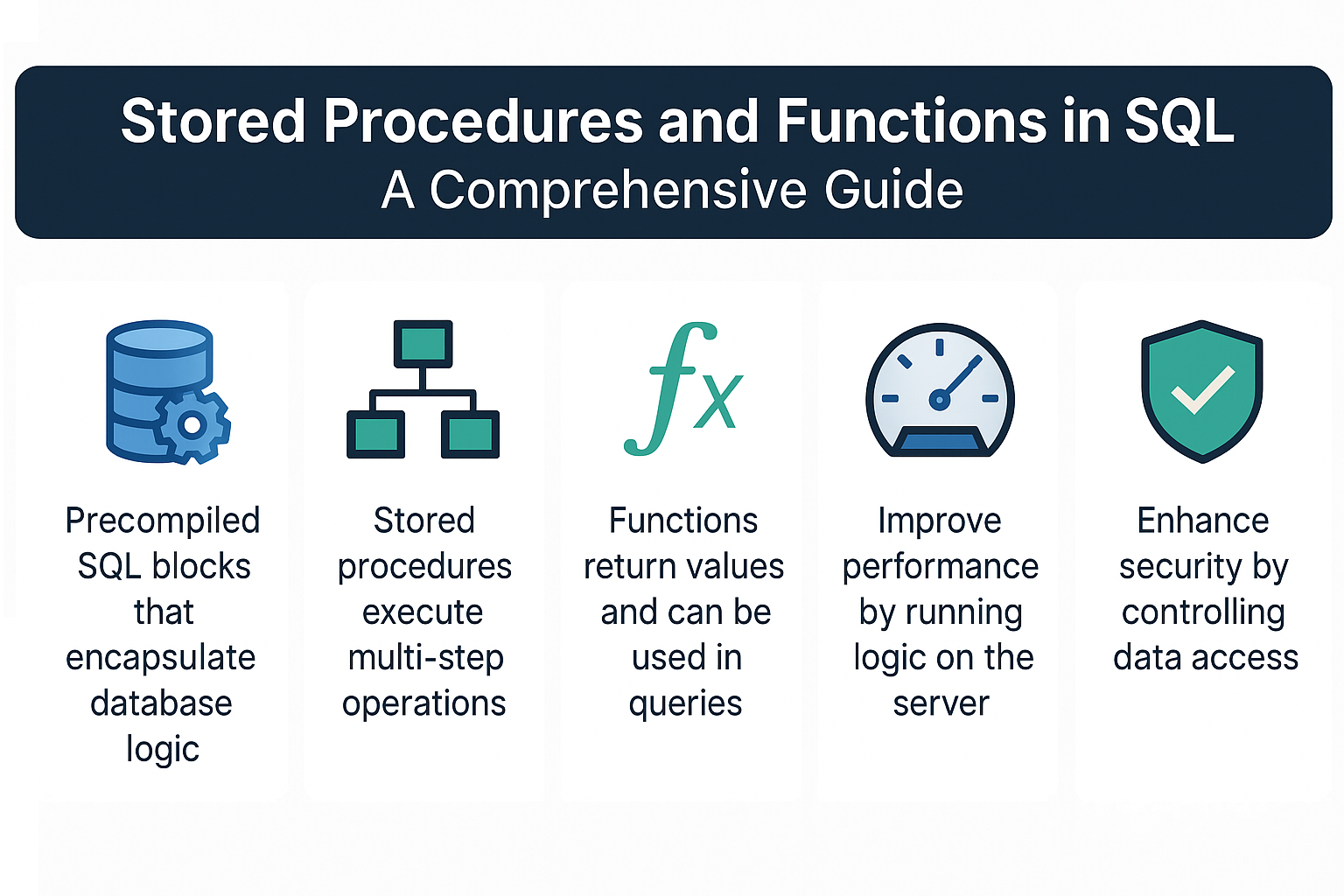Introduction
Stored procedures and functions are precompiled SQL code blocks stored in the database. They allow you to encapsulate logic, perform complex operations, and improve maintainability.
Why They Matter
- Reduce repetitive code in applications.
- Improve performance by executing logic on the database server.
- Enhance security by controlling access to data.
Real-world analogy:
Think of a stored procedure as a saved macro in Excel. Instead of repeating steps, you run the macro once to perform multiple actions.
Core Concepts
Stored Procedure
A block of SQL statements stored in the database and executed as a single unit.
Function
Similar to a stored procedure but always returns a value and can be used in queries.
Key Differences
| Feature | Stored Procedure | Function |
|---|---|---|
| Return Value | Optional | Mandatory |
| Use in Queries | Cannot be used directly | Can be used in SELECT |
| Transaction Control | Can manage transactions | Cannot commit/rollback |
SQL Examples
Creating a Stored Procedure (MySQL)
DELIMITER //
CREATE PROCEDURE transfer_funds(IN from_id INT, IN to_id INT, IN amount DECIMAL)
BEGIN
UPDATE accounts SET balance = balance - amount WHERE account_id = from_id;
UPDATE accounts SET balance = balance + amount WHERE account_id = to_id;
END //
DELIMITER ;
Executing a Stored Procedure
CALL transfer_funds(1, 2, 500);
Creating a Function (PostgreSQL)
CREATE FUNCTION get_total_orders(customer_id INT)
RETURNS INT AS $$
BEGIN
RETURN (SELECT COUNT(*) FROM orders WHERE orders.customer_id = get_total_orders.customer_id);
END;
$$ LANGUAGE plpgsql;
Using the Function
SELECT name, get_total_orders(customer_id) AS total_orders
FROM customers;
Real-World Use Cases
- Banking: Money transfer logic in a stored procedure.
- E-commerce: Functions to calculate discounts or totals.
- Analytics: Predefined summary functions for reports.
Common Mistakes and Anti-Patterns
- Putting too much business logic in procedures: Creates tight coupling.
- Not handling exceptions: Leads to inconsistent data states.
- Using functions for heavy queries in SELECT: Can cause performance issues.
Performance and Scalability Implications
- Stored procedures reduce network overhead by running logic on the server.
- Functions inside SELECT on large datasets can be expensive.
- Precompilation improves execution speed compared to dynamic queries.
RDBMS Comparison
| Feature | PostgreSQL | MySQL | Oracle |
|---|---|---|---|
| Stored Procedures | Supported | Supported | Supported |
| Functions | Supported | Supported | Supported |
| Language Support | PL/pgSQL | SQL/Procedural SQL | PL/SQL |
Best Practices & Optimization Tips
- Use stored procedures for complex multi-step operations.
- Keep functions lightweight and pure for use in queries.
- Handle errors with proper exception handling.
- Document procedures and functions for maintainability.
When to Use vs When to Avoid
Use Stored Procedures When:
- Implementing reusable business logic.
- Performing multi-step database operations.
Use Functions When:
- Returning a single calculated value.
- Embedding logic inside queries.
Avoid When:
- Logic is better handled at the application layer.
- Procedures/functions become monolithic and hard to maintain.
Conclusion & Key Takeaways
Stored procedures and functions are powerful tools for encapsulating database logic. When used correctly, they improve maintainability, performance, and security.
Key Points:
- Stored procedures execute multi-step operations.
- Functions return values and can be used in queries.
- Optimize usage to balance performance and maintainability.
FAQ
1. What is a stored procedure in SQL?
A precompiled block of SQL statements stored in the database.
2. What is the difference between a function and a procedure?
Functions return values and can be used in queries; procedures may not.
3. Are stored procedures faster than queries?
Yes, they are precompiled and reduce network round trips.
4. Can I call a function inside a stored procedure?
Yes, functions can be used within procedures.
5. Are stored procedures secure?
Yes, they help control access and hide underlying tables.
6. Can functions modify data?
Typically no; functions should avoid side effects.
7. Do all RDBMS support stored procedures?
Yes, with syntax variations.
8. What language are they written in?
Depends on RDBMS: PL/pgSQL, PL/SQL, T-SQL, etc.
9. How do I debug stored procedures?
Use logging, exception handling, and RDBMS-specific debugging tools.
10. Should I put all business logic in the database?
No, strike a balance between application and database layers.
